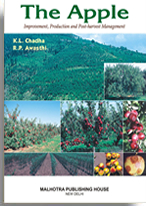Editors : K.L. Chadha and R.P. Awasthi
 Apple
has attained the distinction of being the most important fruit crop of the North
Western Himalayan region of India . Although, the credit for establishing the
first apple orchard in Kullu valley of Himachal Pradesh in 1850 goes to Captain
A.A. Lee, yet the real momentum in its production came after the introduction
of Delicious varieties by Samuel Nicholes Stokes at Kotgarh in Shimla Hills
in 1918. Today, the production of apples from Delicious group of varieties is
highest amongst all the varieties. Apples occupy an area of 2.2 lakh ha with
a production of 1.15 million tonnes which is 2.0% of the total world production
of 58.14 million tonnes.
Apple
has attained the distinction of being the most important fruit crop of the North
Western Himalayan region of India . Although, the credit for establishing the
first apple orchard in Kullu valley of Himachal Pradesh in 1850 goes to Captain
A.A. Lee, yet the real momentum in its production came after the introduction
of Delicious varieties by Samuel Nicholes Stokes at Kotgarh in Shimla Hills
in 1918. Today, the production of apples from Delicious group of varieties is
highest amongst all the varieties. Apples occupy an area of 2.2 lakh ha with
a production of 1.15 million tonnes which is 2.0% of the total world production
of 58.14 million tonnes.
As a result of phenomenal increase in apple production, Horticultural Produce,
Marketing and Processing Corporations (HPMPC) were set up in Himachal &
Jammu & Kashmir for the marketing of apple and its products. Major support
on need based research in variety improvement, production and management was
provided with the establishment of Dr. Y.S. Parmar University of Horticulture
& Forestry, Solan, Himachal Pradesh and S.K. University of Agriculture &
Technology, Srinagar besides a network of Regional Research Stations in Himachal,
Jammu & Kashmir and Uttar Pradesh. Of these, Regional Horticultural Research
Station, Mashobra, Shimla, Regional Research Station, Shalimar, Srinagar and
Regional Research Station, Chaubattia, Uttaranchal have contributed immensely
in recommending varieties for local production and in standardizing the production
technology. The establishment of Central Institute of Temperate Horticulture,
Srinagar and its sub-station at Mukteshwar, Uttaranchal by the Indian Council
of Agricultural Research aims to further strengthen the research infrastructure
at national level.
While, the area under apple has consistently increased, the production has
remained static at 1.5 million tonnes during the past 10 years. The productivity
has shown some increase in Jammu & Kashmir but has decreased in other States
and is lower than in other apple growing countries. In order to match the production
and productivity with other countries, focus needs be given to proper selection
of varieties and rootstocks, quality production of plant material, adoption
of improved training and pruning practices, orchard management, disease and
pest management, post-harvest management, processing and marketing.
In view of the decline in production and productivity, FAO has also launched
a project on apple production and improvement in Himachal Pradesh and Uttaranchal
since March 2003 for capacity building. It broadly aims to improve apple production
through nursery programme, planting material, adoption of selected technologies,
and training.
To give a better insight into all the problems and developments, available
information and research findings on apple production in India have been compiled
in this book titled The Apple: Improvement, Production and Post-harvest Management.
Different topics have been covered by well-known subject matter experts available
in the country in 26 chapters. It is hoped that the book will provide an invaluable
information to the students, teachers, research, extension workers, apple growers
and others interested in apple production in India .
We shall like to convey our sincere thanks to all the scientists who have contributed
different chapters and thus made it possible to share their long experience
in apple production.
Contents
1. History, Challenges and Future Prospects
2. Climate
3. Soils
4. Genetic Resources
5. Varieties
6. Varietal Improvement
7. Propagation
8. Micropropagation
9. Rootstocks
10. Planting
11. Floor Management
12. Training and Pruning
13. Growth and Productivity
14. Nutrition
15. Water Management
16. Quality Improvement
17. Yield Forecasting
18. Fungal Diseases
19. Viral Diseases
20. Post-harvest Diseases
21. Insect and Mite Pests
22. Nematodes
23. Grading, Packing and Storage
24. Fruit Maturity and Harvesting
25. Processing
26. Marketing
Reprinted : ISBN : 81-85048-43-6
524+xii pp.; 113 Colour & B/W photo's; Hardcover
 Apple
has attained the distinction of being the most important fruit crop of the North
Western Himalayan region of India . Although, the credit for establishing the
first apple orchard in Kullu valley of Himachal Pradesh in 1850 goes to Captain
A.A. Lee, yet the real momentum in its production came after the introduction
of Delicious varieties by Samuel Nicholes Stokes at Kotgarh in Shimla Hills
in 1918. Today, the production of apples from Delicious group of varieties is
highest amongst all the varieties. Apples occupy an area of 2.2 lakh ha with
a production of 1.15 million tonnes which is 2.0% of the total world production
of 58.14 million tonnes.
Apple
has attained the distinction of being the most important fruit crop of the North
Western Himalayan region of India . Although, the credit for establishing the
first apple orchard in Kullu valley of Himachal Pradesh in 1850 goes to Captain
A.A. Lee, yet the real momentum in its production came after the introduction
of Delicious varieties by Samuel Nicholes Stokes at Kotgarh in Shimla Hills
in 1918. Today, the production of apples from Delicious group of varieties is
highest amongst all the varieties. Apples occupy an area of 2.2 lakh ha with
a production of 1.15 million tonnes which is 2.0% of the total world production
of 58.14 million tonnes.